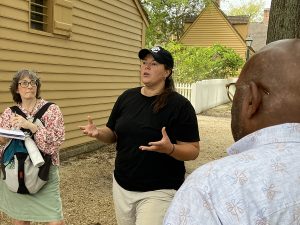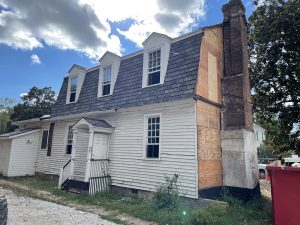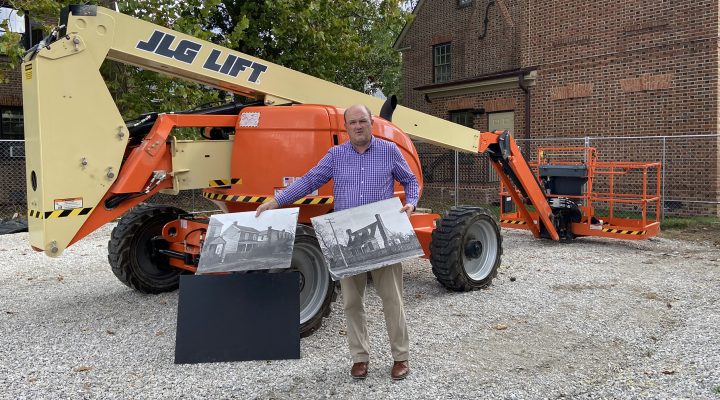Recent archaeological and architectural discoveries revealed part of “the hidden story of racism in colonial America” for participants in a Baptist News Global educational tour of Colonial Williamsburg and Richmond, Va.
In Colonial Williamsburg, they visited the original building site and cemetery of First Baptist Church of Williamsburg, established in 1776 as one of the oldest Black churches in North America. On the nearby campus of the College of William and Mary, they toured the remains of the Bray School, which educated about 300 Black students in the mid-18th century.
Both sites, out-of-sight for generations, testified to the untold history of Black people in the Colonial era.
Both sites, out-of-sight for generations, testified to the untold history of Black people in the Colonial era, as well as provided a metaphor for problems that still persist.
“This is my fifth visit to Colonial Williamsburg. But up to now, I always approached it as a white guy,” BNG Executive Director Mark Wingfield told the group upfront. That was true in large part because the 306-acre museum of Colonial history for many years did not emphasize the story of the community’s Black residents. “But there’s more story to tell, and Colonial Williamsburg is changing,” he added. “We want to see parts of the story we have overlooked.”
‘It’s the economy’
The first large group of Africans arrived in Virginia in 1619, reported Al Lovelace, a retired history teacher who has guided groups through Colonial Williamsburg 49 years.
From 1619 to 1662, Africans were brought to Virginia as indentured servants, who could expect to gain their freedom after five to seven years of hard work, Lovelace said. But in 1662, a new law declared indentured servants would become enslaved permanently.

Colonial Williamsburg guide Al Lovelace explaining to the BNG group the history of the Governor’s Palace and the interesection of church and state.
“The law was driven by economics,” he explained. Virginia thrived by exporting tobacco — a labor-intensive crop — to England. The white farmers wanted a permanent workforce, and slavery was their answer. Even free Africans were not safe, because many were kidnapped and sold into slavery.
By the time of the American Revolution, enslaved people comprised 46% of the Virginia population. In Williamsburg, the enslaved portion of residents was higher, 52%.
In that era, the church and the government — unified under the British monarchy — “denied the humanity of enslaved people,” Lovelace said. “The purpose was to support commerce and the enrichment of the owners. If you were enslaved, you had no rights; you were here to do the work of your master.”
A church arises
Nevertheless, the faith of Black residents thrived. The BNG group crossed paths with James Ingram, a local minister and Colonial Williamsburg actor who portrays Gowan Pamphlet, an enslaved tavern worker who founded First Baptist Church of Williamsburg in 1776.
The church initially met in the woods, because slave codes forbade assembly of large groups of enslaved people, Ingram/Pamphlet noted. But the church eventually included both enslaved and free Blacks, as well as whites. It grew to more than 500 members and became the largest church in America, and Pamphlet was the first Black ordained minister in America.
The church’s popularity soared because Pamphlet grounded his sermons in practical experience and preached on a level and with a passion all people understood, Lovelace said.
Later, the group visited a memorial to Pamphlet’s legacy, but also to how non-white history tends to be shunted aside and often forgotten. They stood just feet from where the foundation of First Baptist Church’s original building has been excavated, and where it will be replicated.
The church constructed that first building — known as the “Black Baptist meeting house” — in 1818. A tornado destroyed that building in 1834, and the church erected a second, much larger, facility in 1856. It stood 100 years, until the Colonial Williamsburg Foundation bought the property and helped the congregation build an even larger building nearby but outside the Colonial district. The foundation razed the 1856 building and replaced it with a parking lot.
They paved paradise and put up a parking lot
That former parking lot is the site of First Baptist’s historic but long-forgotten cemetery, where the Colonial Williamsburg Foundation is conducting an exploration project in cooperation with the church. “We have discovered over 40 burials on this site,” said Lauren McDonald, an archaeological field technician with the foundation and master’s-level student at the College of William and Mary.
That former parking lot is the site of First Baptist’s historic but long-forgotten cemetery.
Workers are proceeding with caution, McDonald said. They are conducting only the third grave excavation, working closely with the church to decide which burial sites to excavate.

Lauren McDonald speaking with the BNG group about the excavcation of a cemetery at the original site of First Baptist Church of Williamsburg.
Some current First Baptist members chart their family heritage back to the early days of the church, she noted. Genetic testing will reveal more about some of the people buried in the cemetery and possibly to their connection to people living today.
But the foundation has a larger purpose in mind. “Our goal is to be able to tell this church’s story,” McDonald said. “Let’s give this the recognition it deserves. We want to give evidence this (cemetery) is here and to celebrate the fact this church community is still here.”
If all goes as planned, a replica of the first church building will be constructed on the original foundation by 2026, when the cemetery area will be established as a commemorative space, McDonald said.
“The people who worshiped here built this town.”
The project represents a vital segment of Colonial Williamsburg’s history, she added. Noting many colonial Virginia Blacks were skilled tradespeople, she stressed, “The people who worshiped here built this town.”
A school for enslaved children rediscovered
Nearby, on the edge of the College of William and Mary, the BNG group toured another piece of long-lost African American history.
The Bray School, created to educate free and enslaved Black children, opened in Williamsburg on Sept. 29, 1760, in a rented home. Across the next 15 years, the Bray School taught about 300 children.

The Bray School building as it appeared on Sept. 7, 2022, when visited by the BNG group. Wings that were later additions have been removed, but the roofline has not yet been returned to its original state. Next year, the historic building will be moved to a site inside Colonial Williamsburg.
The Associates of Dr. Bray, a London-based philanthropy, funded the school as part of a venture aimed at several Colonial cities. But the school’s philanthropic trappings masked a darker intent, said Matt Webster, executive director of Colonial Williamsburg’s Grainger Department of Architectural Preservation and Research.
“This was a pro-slavery school,” Webster explained. Although the children learned to read, write and do arithmetic, they also heard lessons about slavery being God’s design for them. “But once you educate someone, you cannot control what they do with it,” he added, pointing to evidence the children built upon their knowledge and critical thinking to learn lessons the school’s supporters did not intend.
“Once you educate someone, you cannot control what they do with it.”
The school functioned up until the eve of the American Revolution, when its longtime teacher died. Over time, people lost the connection between the building and the school. After construction of wings on either end of the building and a re-worked roofline, it did not resemble aged pictures of a two-story home with dormers across the roof.
But some wondered if the old white building, which had served various purposes for the college — including as a dormitory — across the years, might be the original Bray School home.
Webster and his team started examining the building in 2020. They conducted dendrochronology studies — a process of dating buildings by studying the tree rings in their wooden structures. They confirmed the lumber in the building had been harvested in 1759 and 1760, just in time for construction of the building as records indicated.
Webster took the BNG group inside the nearly gutted facility and pointed out indications of how the building had been altered across the years. He also showed how original features, such as chair railings and ceiling joists, had been repurposed in the renovations.
Colonial Williamsburg will move the Bray School building from the William and Mary campus to a lot immediately adjacent to the original First Baptist Church property early next year. Webster and his team will set out to renovate the facility so that it will as closely as possible resemble the original structure.
Side-by-side, the replica of the original First Baptist building, the commemorative space at the cemetery and the Bray School will enable Colonial Williamsburg to tell the story of racism, slavery and Black contributions to Colonial America much more fully.
Amazement and grief
After a long day of touring these sites and talking with people who have committed their lives to preserving them, the BNG group celebrated and lamented.
They felt gratitude for the contributions of First Baptist Church of Williamsburg, the mixed legacy of the Bray School and the experts who are making them visible again. But they grieved how a parking lot on top of a cemetery and an almost-lost historic building provide metaphors of privilege-induced white superiority, which blinds millions from seeing Black contributions to society and from recognizing how racism continues to bind, even though U.S. slavery officially ended almost 160 years ago.
Related articles:
Friday Roundup: Where the bodies are buried
Whether blind, blurry or oblivious, failure to see whiteness distorts God’s image in others
Voices of freedom continue to speak from Colonial Williamsburg church
How we’re learning to see and hear the Black experience at Colonial Williamsburg | Analysis by Ella Wall Prichard
The power of a pamphlet | Opinion by Elijah Zehyoue


